These images can be downloaded free of charge. Clicking on the negative
number hyperlink will download a high-resolution 300dpi jpeg version of the
image. The high-resolution images are large files, over 1 MB each, and may
take a while to load depending on the speed of your connection. If you need these images in a different format or resolution,
please e-mail jane@bnl.gov or call (631)
344-2345.
| |
|
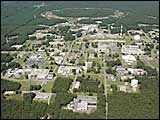 |
D2800907
Aerial view of Brookhaven National Laboratory taken in August
2007. The Relativistic
Heavy Ion Collider (top, center) is 2.4 miles in circumference, and
dominates Brookhaven's 5,265-acre campus. |
| |
|
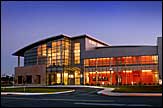 |
D2800907
The Center for Functional Nanomaterials at Brookhaven National Laboratory
photographed at dusk |
| |
|
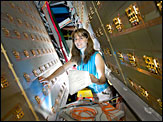 |
D0230708
Christine Aidala, a member of RHIC's PHENIX experiment, is seen
here inside the PHENIX detector itself. |
| |
|
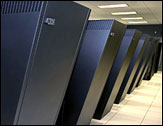 |
D1950607
Stony Brook University and Brookhaven National Laboratory
operate one of the most powerful supercomputers in the world.
The IBM Blue Gene supercomputer, named New York Blue and located
at Brookhaven Lab, is the world's fastest supercomputer for
general users and is expected to rank among the top ten fastest
computers in the world. |
| |
|
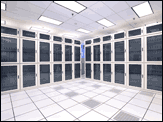 |
D2160505
Known as QCDOC machines, for quantum chromodynamics (QCD) on a
chip, these supercomputers perform the complex calculations of
the theory that describes the interactions of quarks and gluons
and the force that holds atomic nuclei together. |
| |
|
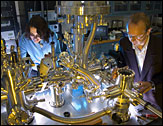
|
D0420407
Nanotechnology: BNL researchers Eli and Peter Sutter have shown that
tiny droplets of liquid metal freeze much differently than their larger
counterparts. This study, focused on droplets just a billionth of a
trillionth of a liter in size.
|
| |
|
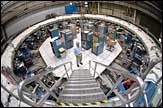 |
D1951205
The muon g-2 storage ring. This ring, in concert with a beam supplied by
the Alternating Gradient Synchrotron, was used to make the first precise
measurement of how negatively charged muons "wobble" in the magnetic
field, information which can be used to confirm the Standard Model of
particle physics. |
|
|
|
 |
NASA Space Radiation Laboratory (NSRL) researcher Debasish Roy places a
sample into the NSRL beam line. |
|
|
|
 |
Staff from the Laboratory's Superconducting Magnet Division examine a
"snake" magnet used at the Alternating Gradient Synchrotron. Snake
magnets are used to flip the spin of the protons as they travel around an
accelerator to eliminate depolarization, called “resonances,” which occur
during acceleration. |
|
|
|
 |
(No negative number)
An end view of collision between deuterons and gold ions captured by the
STAR detector at Brookhaven's Relativistic Heavy Ion Collider (RHIC). |
|
|
|
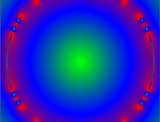 |
(No negative number)
Image of the strength of the magnetic field produced by a superconducting
quadrupole magnet built by the BNL Superconducting Magnet Division for the
HERA electron-proton collider at the DESY Laboratory in Hamburg, Germany.
It was built using technology developed at BNL for manufacturing some of
the specialized magnets for the RHIC facility.
|
|
|
|
 |
Brookhaven's main gate sign.
The Laboratory is operated by Brookhaven Science Associates,
a not-for-profit research management company, under contract
with the U.S. Department of Energy. |
|
|
|
 |
RHIC's "siberian snake" magnets have a corkscrew-like design, which
causes the direction of the magnetic field to spiral along the
direction of the beam. There are two snakes in each of RHIC’s two
2.4-mile-circumference rings, located at opposite sides of each
ring. As the beam moves through the snakes, the magnetic field flips
the polarization allowing scientists to maintain a stable beam.
|
|
|
|

|
The Positron Emission Tomography (PET) facility. Brookhaven is a
world leader in brain research, including how drugs, mental illness,
nicotine, alcohol and even normal aging affect the brain.
|
|
|
|
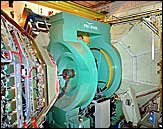 |
D2290703
PHENIX is one of the four large detectors that helps physicists analyze
the particle collisions at Brookhaven's Relativistic Heavy Ion Collider
(RHIC). PHENIX weighs 4,000 tons and has a dozen detector subsystems.
Three large steel magnets produce high magnetic fields to bend
charged particles along curved paths.
|
|
|
|
 |
PHENIX is one of the four large detectors that helps physicists analyze
the particle collisions at Brookhaven's Relativistic Heavy Ion Collider
(RHIC). PHENIX weighs 4,000 tons and has a dozen detector subsystems.
Three large steel magnets produce high magnetic fields to bend charged
particles along curved paths. |
|
|
|
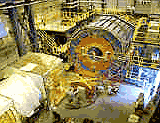 |
The STAR detector at Brookhaven's Relativistic Heavy Ion Collider (RHIC).
As big as a house, STAR searches for signatures of the form of matter that
RHIC aims to create: the quark-gluon plasma. |
|
|
|
 |
(No negative number)
End view of a collision of two 30-billion electron-volt gold
beams in the STAR detector at the Relativistic Heavy Ion Collider at
Brookhaven National Laboratory. The beams travel in opposite directions at
nearly the speed of light before colliding. |
| |
|
 |
Brookhaven's National Synchrotron Light Source is a major user
facility at the Lab, drawing close to 2,500 visiting researchers
each year from industry, universities and other laboratories. They
use the Light Source's intense beams of x-rays and ultraviolet light
to carry out a wide range of studies in diverse scientific fields.
|
| |
|
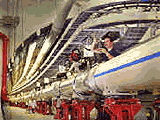 |
A view of the superconducting magnets at Brookhaven's Relativistic
Heavy Ion Collider. As gold particles zip along the collider's 2.4
mile long tunnel at nearly the speed of light, 1,740 of these
magnets guide and focus the particle beams.
|
| |
|
 |
Brookhaven's National Synchrotron Light Source (NSLS) attracts about
2,500 scientists each year from academia, industry and other labs to
use the facility's powerful x-rays, ultraviolet light and infrared
light.
|
|
|
|
 |
The Brookhaven-developed fan-atomized oil burner offers improved
fuel- and air-mixing for better performance. |
|
|
|
 |
A normal brain (top) and a cocaine abuser's 10 and 100 days after
taking the drug. Normal metabolic activity, indicated by bright red
and yellow, is blunted in the drug abuser. |
|
|
|
 |
Nanoscale arrangement: Sulfur atoms form "dancing triangles" on
copper. |
|
|
|
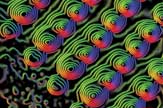 |
Map showing magnetic flux lines for nickel nanoparticles |
|
|
|



